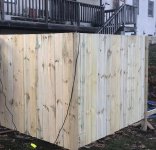The sensor on this thing is not so good, I think. Or it's not well-calibrated to the adjustment range. Or I can't test while it's running? Zeropoint of 15 resulted in it turning on at 1.2 as I previously mentioned. Running for three hours then raised the free chlorine by 2 to 3.2ppm plus the dichlor I added, so that run time seems pretty good if I can get it to turn on at 2ppm or above. As you folks suggested, I increased the zeropoint, I think to 20, maybe 25 but I went too high I guess, because the next time I checked, the free chlorine was at 13 ppm with the cell still operating. Keep in mind, the zeropoint range of adjustment is 0-60. Anyway, I set it back down to 17, and waited for the chlorine levels to fall. We used it last night. FC before we soaked: 6.0ppm.
FC this morning, after we soaked, 1.4ppm and the cell was still off. So 17 is still too low. Bumped zeropoint to 18. Will wait and see.
FC this morning, after we soaked, 1.4ppm and the cell was still off. So 17 is still too low. Bumped zeropoint to 18. Will wait and see.




